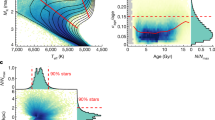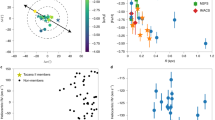Abstract
The chemical composition of the most metal-deficient stars largely reflects the composition of the gas from which they formed. These old stars provide crucial clues to the star formation history and the synthesis of chemical elements in the early Universe. They are the local relics of epochs otherwise observable only at very high redshifts1,2; if totally metal-free (‘population III’) stars could be found, this would allow the direct study of the pristine gas from the Big Bang. Earlier searches for such stars found none with an iron abundance less than 1/10,000 that of the Sun3,4, leading to the suggestion5,6 that low-mass stars could form from clouds above a critical iron abundance. Here we report the discovery of a low-mass star with an iron abundance as low as 1/200,000 of the solar value. This discovery suggests that population III stars could still exist—that is, that the first generation of stars also contained long-lived low-mass objects. The previous failure to find them may be an observational selection effect.
This is a preview of subscription content, access via your institution
Access options
Subscribe to this journal
Receive 51 print issues and online access
$199.00 per year
only $3.90 per issue
Buy this article
- Purchase on Springer Link
- Instant access to full article PDF
Prices may be subject to local taxes which are calculated during checkout

Similar content being viewed by others
Notes
* The citation of Fig. 1 was omitted in all print issues, and the citation of Table 1 was omitted in certain print issues.
References
Norris, J. E., Ryan, S. G. & Beers, T. C. Extremely metal-poor stars. VIII. High-resolution, high signal-to-noise ratio analysis of five stars with [Fe/H] < -3.5. Astrophys. J. 561, 1034–1059 (2001)
Cohen, J. G., Christlieb, N., Beers, T. C., Gratton, R. & Carretta, E. Stellar archaeology: A Keck pilot program on extremely metal-poor stars from the Hamburg/ESO survey. I. Stellar parameters. Astron. J. 124, 470–480 (2002)
Bond, H. E. Where is population III? Astrophys. J. 248, 606–611 (1981)
Beers, T. C. in The Third Stromlo Symposium: The Galactic Halo (eds Gibson, B. K., Axelrod, T. S. & Putman, M. E.) Astron. Soc. Pacif. Conf. Ser. 165, 202–212 (1999).
Bromm, V., Ferrara, A., Coppi, P. S. & Larson, R. B. The fragmentation of pre-enriched primordial objects. Mon. Not. R. Astron. Soc. 328, 969–976 (2001)
Schneider, R., Ferrara, A., Natarajan, P. & Omukai, K. First stars, very massive black holes, and metals. Astrophys. J. 571, 30–39 (2002)
Wisotzki, L. et al. The Hamburg/ESO survey for bright QSOs. III. A large flux-limited sample of QSOs. Astron. Astrophys. 358, 77–87 (2000)
Christlieb, N. et al. The stellar content of the Hamburg/ESO survey. I. Automated selection of DA white dwarfs. Astron. Astrophys. 366, 898–912 (2001)
Yi, S. et al. Towards better age estimates for stellar populations: The Y2 isochrones for solar mixture. Astrophys. J. Suppl. 136, 417–437 (2001)
Mathis, J. S. & Lamers, H. J. G. L. M. The origin of the extremely metal-poor post-AGB stars. Astron. Astrophys 259, L39–L42 (1992)
Van Winckel, H., Waelkens, C. & Waters, L. B. F. M. The extremely iron-deficient “post-AGB” stars and binaries. Astron. Astrophys. 293, L25–L28 (1995)
Waters, L. B. F. M., Trams, N. R. & Waelkens, C. A scenario for the selective depletion of stellar atmospheres. Astron. Astrophys. 262, L37–L40 (1992)
Bakker, E. J. et al. The optical spectrum of HR 4049. Astron. Astrophys. 306, 924–934 (1996)
Woosley, S. E. & Weaver, T. A. The evolution and explosion of massive stars. II. Explosive hydrodynamics and nucleosynthesis. Astrophys. J. 101, 181–235 (1995)
Yoshii, Y. Metal enrichment in the atmospheres of extremely metal-deficient dwarf stars by accretion of interstellar matter. Astron. Astrophys. 97, 280–290 (1981)
McClure, R. D. & Woodsworth, A. W. The binary nature of the Barium and CH stars. III. Orbital parameters. Astrophys. J. 352, 709–723 (1990)
Fujimoto, M. Y., Ikeda, Y. & Iben, I. Jr The origin of extremely metal-poor carbon stars and the search for population III. Astrophys. J. 529, L25–L28 (2000)
Schlattl, H., Salaris, M., Cassisi, S. & Weiss, A. The surface carbon and nitrogen abundances in models of ultra metal-poor stars. Astron. Astrophys. (2002) (in the press); also preprint astro-ph/0205326 at 〈http://xxx.lanl.gov〉
Siess, L., Livio, M. & Lattanzio, J. Structure, evolution, and nucleosynthesis of primordial stars. Astrophys. J. 570, 329–343 (2002)
Norris, J., Ryan, S. G. & Beers, T. C. Extremely metal poor stars. The carbon-rich, neutron capture element-poor object CS 22957 - 027. Astrophys. J. 489, L169–L172 (1997)
Aoki, W., Norris, J. E., Ryan, S. G., Beers, T. C. & Ando, H. The chemical composition of carbon-rich, very metal poor stars: a new class of mildly carbon rich objects without excess of neutron-capture elements. Astrophys. J. 567, 1166–1182 (2002)
Yoshii, Y. & Sabano, Y. Stability of a collapsing pre-Galactic gas cloud. Publ. Astron. Soc. Jpn 31, 505–521 (1979)
Palla, F., Salpeter, E. E. & Stahler, S. W. Primordial star formation: the role of molecular hydrogen. Astrophys. J. 271, 632–641 (1983)
Gass, H., Liebert, J. & Wehrse, R. Spectrum analysis of the extremely metal-poor carbon dwarf star G77-61. Astron. Astrophys. 189, 194–198 (1988)
Yoshii, Y. & Saio, H. Initial mass function for zero-metal stars. Astrophys. J. 301, 587–600 (1986)
Nakamura, F. & Umemura, M. On the initial mass function of population III stars. Astrophys. J. 548, 19–32 (2001)
Ostriker, J. P. & Gnedin, N. Y. Reheating of the universe and population III. Astrophys. J. 472, L63–L67 (1996)
Ryan, S. G., Norris, J. E. & Beers, T. C. The Spite lithium plateau: ultrathin but postprimordial. Astrophys. J. 523, 654–677 (1999)
Cayrel, R. et al. Measurement of stellar age from uranium decay. Nature 409, 691–692 (2001)
Acknowledgements
We thank the European Southern Observatory for providing us with reduced UVES spectra. We are grateful to M. Asplund, B. Edvardsson, J. Lattanzio, J. Norris, N. Piskunov, B. Plez, D. Reimers, S.G. Ryan, L. Siess and L. Wisotzki for their contributions and suggestions. N.C. acknowledges a Marie Curie Fellowship granted by the European Commission, and support from Deutsche Forschungsgemeinschaft. T.C.B. acknowledges grants of the US National Science Foundation, S.R. support from FAPESP and CNPq, and the Uppsala group from the Swedish Research Council.
Author information
Authors and Affiliations
Corresponding author
Ethics declarations
Competing interests
The authors declare that they have no competing financial interests.
Rights and permissions
About this article
Cite this article
Christlieb, N., Bessell, M., Beers, T. et al. A stellar relic from the early Milky Way. Nature 419, 904–906 (2002). https://doi.org/10.1038/nature01142
Received:
Accepted:
Issue Date:
DOI: https://doi.org/10.1038/nature01142
This article is cited by
Comments
By submitting a comment you agree to abide by our Terms and Community Guidelines. If you find something abusive or that does not comply with our terms or guidelines please flag it as inappropriate.



